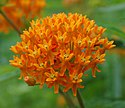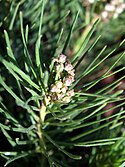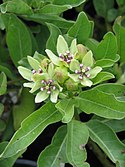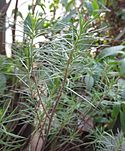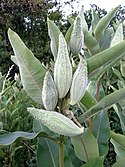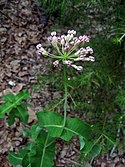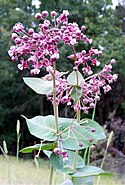Seidenpflanzen
| Seidenpflanzen | ||||||||||||
|---|---|---|---|---|---|---|---|---|---|---|---|---|
 Asclepias tuberosa | ||||||||||||
| Systematik | ||||||||||||
| ||||||||||||
| Wissenschaftlicher Name | ||||||||||||
| Asclepias | ||||||||||||
| L. |
Die Seidenpflanzen (Asclepias) sind eine Pflanzengattung in der Unterfamilie der Seidenpflanzengewächse (Asclepiadoideae) innerhalb der Familie der Hundsgiftgewächse (Apocynaceae). Ihr ursprüngliches Verbreitungsgebiet ist hauptsächlich die Neue Welt und das tropische Afrika, einige Arten sind in vielen Gebieten der Welt Neophyten.
Beschreibung



Erscheinungsbild und Blätter
Asclepias-Arten wachsen meist als ausdauernde, selten als einjährige krautige Pflanzen; die meisten Arten verholzen an der Basis etwas.
Meist sind die höchstens kurz gestielten Laubblätter gegenständig oder seltener stehen sie in Quirlen an den Stängeln angeordnet. Die krautigen Blattspreiten sind mit einer Länge von 2 bis 17 Zentimetern und einer Breite von 0,1 bis 3 Zentimetern linealisch, dreieckig, elliptisch oder länglich, mit gerundeter, keilförmiger oder stumpfer Spreitenbasis und spitzen oder zugespitzten oberen Enden. Die Blattflächen können kahl bis flaumig behaart sein.
Blütenstände und Blüten
Die endständigen oder zwischen den Knoten (Nodien) entspringenden, doldenähnlichen, zymösen Blütenstände sind wenig- bis meist vielblütig. Die Blütenstandsschäfte sind meist mindestens so lang wie die Blütenstiele, manchmal fehlen sie.
Die zwittrigen Blüten sind radiärsymmetrisch und meist fünfzählig mit doppelter Blütenhülle. Die meist fünf Kelchblätter sind verwachsen und unterseits behaart oder kahl. Die meist fünf nur an ihrer Basis verwachsenen Kronblätter sind aufrecht bis zurückgeschlagen. Es ist nur ein Kreis mit fünf Staubblättern vorhanden. Die Staubfäden und der Spitzenbereich der Fruchtblätter sind zu einem so genannten Gynostegium verwachsen. Das aufrechte Gynostegium besitzt eingekrümmte, zungen-hornähnliche Anhängsel. Die zwei oberständigen Fruchtblätter sind untereinander frei.
Früchte und Samen
Je befruchteter Blüte entstehen zwei Balgfrüchte, die meist wie zwei Hörner zusammenstehen. Die spindelförmigen Balgfrüchte besitzen ein spitzes Ende und enthalten dicht gepackt viele flache Samen, die als Flugorgane 15 bis 40 mm lange, seidige Haare besitzen (Coma) (daher der Name Seidenpflanzen).
Ökologie
Die Blüten enthalten Nektar. Die Bestäubung erfolgt meist durch Insekten (Entomophilie).
Systematik und Verbreitung
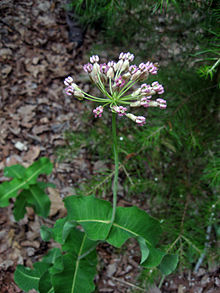








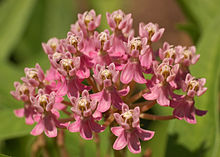
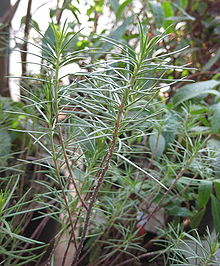
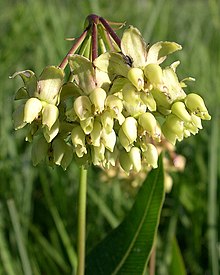

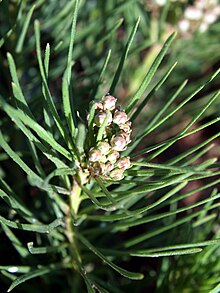



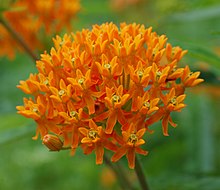



Die Erstveröffentlichung des Gattungsnamens Asclepias erfolgte 1753 durch Carl von Linné in Species Plantarum, 1, S. 214–217. Als Lectotypus wurde in Hitchcock: Prop. Brit. Bot. 1929, S. 136, Asclepias syriaca festgelegt.[1] Carl von Linné hat den botanischen Gattungsnamen Asclepias von Asklepios abgeleitet, dem griechischen Gott der Heilkunst, da sie häufig in der Volksmedizin verwendet wurde. Synonyme für AsclepiasL. sind: AceratesElliott, AnantherixNutt., AsclepiodellaSmall, AsclepiodoraA.Gray, BiventrariaSmall, OxypteryxGreene, PodostemmaGreene, PodostigmaElliott, SchizonotusA.Gray, SolanoaGreene.
Die Gattung Asclepias gehört zur Subtribus Asclepiadinae aus der Tribus Asclepiadeae in der Unterfamilie der Asclepiadoideae innerhalb der Familie der Apocynaceae.[2]
Das ursprüngliche Verbreitungsgebiet der Gattung Asclepias ist hauptsächlich die Neue Welt und das tropische Afrika. Einige Arten sind in vielen Gebieten der Welt Neophyten.
Zur Gattung der Seidenpflanzen (Asclepias) gehören über 200 Arten:[3]
- Asclepias adscendens(Schltr.) Schltr.: Sie kommt vom östlichen Simbabwe bis zum südlichen Afrika vor.[3]
- Asclepias ×aequicornuE.Fourn. = Asclepias candida × Asclepias mellodora: Sie kommt in Brasilien und im argentinischen Misiones vor.[3]
- Asclepias albens(E.Mey.) Schltr.[3]
- Asclepias albicansS.Watson[3]
- Asclepias alpestris(K.Schum.) Goyder (Syn.: Schizoglossum alpestreK.Schum.): Diese Neukombination erfolgte 2009. Dieser Endemit kommt nur im südwestlichen Tansania vor.[4][3]
- Asclepias amabilisN.E.Br.[3]
- Asclepias ameliaeS.Moore[3]
- Asclepias amplexicaulisSm.[3]
- Asclepias angustifoliaSchweigg.[3]
- Asclepias apocynifoliaWoodson[3]
- Asclepias arenariaTorr.[3]
- Asclepias asperula(Decne.) Woodson: Sie kommt von den westlichen und zentralen Vereinigten Staaten bis zum nördlichen Mexiko vor. Es gibt zwei Unterarten:[3]
- Asclepias atroviolaceaWoodson[3]
- Asclepias aurea(Schltr.) Schltr.[3]
- Asclepias auriculataKunth[3]
- Asclepias barjoniifoliaE.Fourn.[3]
- Asclepias bartlettianaWoodson[3]
- Asclepias baumiiSchltr.[3]
- Asclepias bicuspisN.E.Br.[3]
- Asclepias bifidaW.H.Blackw.[3]
- Asclepias boliviensisE.Fourn.[3]
- Asclepias brachystephanaEngelm. ex Torr.[3]
- Asclepias bracteolataE.Fourn.[3]
- Asclepias breviantheraeGoyder: Sie wurde 2009 erstbeschrieben mit zwei Unterarten:[4][3]
- Asclepias brevicuspis(E.Mey.) Schltr.[3]
- Asclepias brevipes(Schltr.) Schltr.[3]
- Asclepias ×bridgesiiE.Fourn.[3]
- Asclepias buchwaldii(Schltr. & K.Schum.) De Wild.[3]
- Kalifornische Seidenpflanze (Asclepias californicaGreene): Es gibt zwei Unterarten:[3]
- Asclepias candidaVell.[3]
- Asclepias cinereaWalter[3]
- Asclepias circinalis(Decne.) Woodson[3]
- Asclepias compressidens(N.E.Br.) Nicholas[3]
- Asclepias concinna(Schltr.) Schltr.[3]
- Asclepias connivensBaldwin ex Elliott[3]
- Asclepias constrictaM.E.Jones[3]
- Asclepias conzattiiWoodson[3]
- Asclepias cooperiN.E.Br.[3]
- Asclepias cordifolia(Benth.) Jeps.[3]
- Asclepias coulteriA.Gray[3]
- Asclepias crassicoronataGoyder: Sie wurde 2009 erstbeschrieben. Sie kommt vom südwestlichen Tansania bis zum nördlichen Sambia vor.[3]
- Asclepias crassinervisN.E.Br.[3]
- Asclepias crispaP.J.Bergius[3]
- Asclepias croceaWoodson[3]
- Asclepias cryptocerasS.Watson: Es gibt zwei Unterarten:[3]
- Asclepias cucullata(Schltr.) Schltr.: Es gibt seit 2001 zwei Unterarten:[3]
- Asclepias cultriformisHarv. ex Schltr.[3]
- Indianer-Seidenpflanze (Asclepias curassavicaL.)[3]
- Asclepias curtissiiA.Gray[3]
- Asclepias cutleriWoodson[3]
- Asclepias densifloraN.E.Br.[3]
- Asclepias dependens(K.Schum.) N.E.Br.[3]
- Asclepias depressa(Schltr.) Schltr.[3]
- Asclepias dinteriEngl. & Krause[3]
- Asclepias disparilisN.E.Br.[3]
- Asclepias dissonaN.E.Br.[3]
- Asclepias dregeanaSchltr.[3]
- Asclepias edentataGoyder:[4] Sie wurde 2009 aus dem südwestlichen Tansania erstbeschrieben.[3]
- Asclepias elataBenth.[3]
- Asclepias elegantulaFishbein: Sie wurde 2008 aus dem nördlichen Mexiko erstbeschrieben.[3]
- Asclepias eminens(Harv.) Schltr.[3]
- Asclepias emoryi(Greene) Vail ex Small[3]
- Asclepias engelmannianaWoodson[3]
- Asclepias eriocarpaBenth.[3]
- Asclepias erosaTorr.[3]
- Asclepias euphorbiifoliaEngelm. ex A.Gray[3]
- Asclepias exaltataL.[3]
- Asclepias expansa(E.Mey.) Schltr.[3]
- Asclepias fallax(Schltr.) Schltr.[3]
- Asclepias fascicularisDecne.[3]
- Asclepias feayiChapm. ex A.Gray[3]
- Asclepias fimbriataWeim.[3]
- Asclepias flanaganiiSchltr.[3]
- Asclepias flexuosa(E.Mey. ex Decne.) Schltr.[3]
- Asclepias foliosa(K.Schum.) Hiern[3]
- Asclepias fournieriWoodson[3]
- Asclepias fulvaN.E.Br.[3]
- Asclepias galeottiiE.Fourn.[3]
- Asclepias gentryiStandl.[3]
- Asclepias gibba(E.Mey.) Schltr.: Es gibt zwei Varietäten, die beide im südlichen Afrika vorkommen:[3]
- Asclepias glaucescensKunth[3]
- Asclepias gordon-grayaeNicholas[3]
- Asclepias graminifolia(Wild) Goyder: Diese Neukombination erfolgte 2009. Sie kommt nur in Simbabwe vor.[3]
- Asclepias grandirandiiGoyder: Sie wurde 2009 erstbeschrieben und kommt vom westlichen Tansania bis zum nordöstlichen Sambia vor.[4][3]
- Asclepias halliiA.Gray[3]
- Asclepias hirtella(Pennell) Woodson[5][3]
- Asclepias humilis(E.Mey.) Schltr.[3]
- Asclepias humistrataWalter[3]
- Asclepias hypoleuca(A.Gray) Woodson[3]
- Asclepias inaequalisGoyder: Sie wurde 2009 aus dem südwestlichen Tansania erstbeschrieben.[4][3]
- Sumpf-Seidenpflanze (Asclepias incarnataL.): Sie kommt vom zentralen und östlichen Kanada bis zu den westlich-zentralen und östlichen Vereinigten Staaten vor. Es gibt zwei Unterarten:[3]
- Asclepias involucrataEngelm. ex Torr.[3]
- Asclepias jaliscanaB.L.Rob.[3]
- Asclepias jorgeanaFishbein & S.P.Lynch[3]
- Asclepias kamerunensisSchltr.[3]
- Asclepias ×kansanaVail[3]
- Asclepias labriformisM.E.Jones[3]
- Asclepias lanceolataWalter[3]
- Asclepias langsdorffiiE.Fourn.[3]
- Asclepias lanuginosaNutt.[3]
- Asclepias latifolia(Torr.) Raf.[3]
- Asclepias lemmoniiA.Gray[3]
- Asclepias leptopusI.M.Johnst.[3]
- Asclepias linariaCav.[3]
- Asclepias linearisScheele[3]
- Asclepias longifoliaMichx.[5][3]
- Asclepias longirostraGoyder: Sie wurde 2009 aus Malawi erstbeschrieben.[4][3]
- Asclepias longissima(K.Schum.) N.E.Br.[3]
- Asclepias lynchianaFishbein[3]
- Asclepias macropus(Schltr.) Schltr.[3]
- Asclepias macrotisTorr.[3]
- Asclepias masoniiWoodson[3]
- Asclepias mcvaughiiWoodson[3]
- Asclepias meadiiTorr. ex A.Gray[3]
- Asclepias melanthaDecne.[3]
- Asclepias meliodora(Schltr.) Schltr.[3]
- Asclepias mellodoraA.St.-Hil.[3]
- Asclepias mexicanaCav.[3]
- Asclepias meyeriana(Schltr.) Schltr.[3]
- Asclepias michauxiiDecne.[4][3]
- Asclepias minor(S.Moore) Goyder[4][3]
- Asclepias minutiflora(Goyder) Goyder: Diese Neukombination erfolgte 2009.[4][3]
- Asclepias mirificaWoodson[3]
- Asclepias montevagaM.Glen, Nicholas & Bester[3]
- Asclepias monticolaN.E.Br.[3]
- Asclepias mtorwiensisGoyder: Sie wurde 2009 erstbeschrieben.[4] Dieser Endemit kommt nur in den Kipengere Bergen in Tansania vor.[3]
- Asclepias nanaI.Verd.[3]
- Asclepias navicularis(E.Mey.) Schltr.[3]
- Asclepias niveaL.: Es gibt zwei Varietäten:[3]
- Asclepias nummulariaTorr.[3]
- Asclepias nummularioidesW.D.Stevens[3]
- Asclepias nuttiiN.E.Br.[3]
- Asclepias nyctaginifoliaA.Gray[3]
- Asclepias obovataElliott[3]
- Asclepias occidentalisGoyder: Sie wurde 2009 aus dem westlich-zentralen tropischen Afrika erstbeschrieben.[4][3]
- Asclepias oenotheroidesSchltdl. & Cham.[3]
- Asclepias oreophilaNicholas ex Hilliard & B.L.Burtt[3]
- Asclepias otarioidesE.Fourn.[3]
- Asclepias ovalifoliaDecne.[3]
- Asclepias ovataM.Martens & Galeotti[3]
- Asclepias palustris(K.Schum.) Schltr.[3]
- Asclepias patensN.E.Br.[3]
- Asclepias pedicellataWalter[3]
- Asclepias pellucidaE.Fourn.[3]
- Asclepias peltigera(E.Mey.) Schltr.[3]
- Asclepias perennisWalter[3]
- Asclepias pilgerianaSchltr.[3]
- Asclepias praemorsaSchltr.[3]
- Asclepias pratensisBenth.[3]
- Asclepias pringlei(Greenm.) Woodson[3]
- Asclepias prostrataW.H.Blackw.[3]
- Asclepias pseudoamabilisGoyder: Sie wurde 2009 aus dem westlichen Tansania erstbeschrieben.[4][3]
- Asclepias pseudofimbriata(Goyder) Goyder: Diese Neukombination erfolgte 2009. Sie kommt nur in Äthiopien vor.[4][3]
- Asclepias pseudorubricaulisWoodson[3]
- Asclepias puberulaA.Gray[3]
- Asclepias pumila(A.Gray) Vail[3]
- Asclepias purpurascensL.[3]
- Asclepias pygmaeaN.E.Br.[3]
- Asclepias quadrifoliaJacq.[3]
- Asclepias quinquedentataA.Gray[3]
- Asclepias randiiS.Moore[3]
- Asclepias raraN.E.Br.[3]
- Asclepias rubraL.[3]
- Asclepias rusbyi(Vail) Woodson[3]
- Asclepias scaposaVail[3]
- Asclepias scheryiWoodson[3]
- Asclepias schlechteri(K.Schum.) N.E.Br.[3]
- Asclepias schumannianaHiern[3]
- Asclepias senecionifoliaM.E.Jones[3]
- Asclepias shabaensis(Goyder) Goyder: Diese Neukombination erfolgte 2009. Sie kommt nur in Zaire vor.[4][3]
- Asclepias similisHemsl.[3]
- Asclepias solanoanaWoodson[3]
- Asclepias solstitialisA.Chev.[3]
- Stachlige Seidenpflanze (Asclepias speciosaTorr.)[3]
- Asclepias sperryiWoodson[3]
- Asclepias sphacelata(K.Schum.) N.E.Br.[3]
- Asclepias standleyiWoodson[3]
- Asclepias stathmostelmoidesGoyder: Sie wurde 2009 erstbeschrieben und kommt von Burundi bis zum tropischen südlichen Afrika vor.[4][3]
- Asclepias stelliferaSchltr.[3]
- Asclepias stenophyllaA.Gray[3]
- Asclepias subaphyllaWoodson[3]
- Asclepias subulataDecne.[3]
- Asclepias subverticillata(A.Gray) Vail[3]
- Asclepias subviridisS.Moore[3]
- Asclepias sullivantiiEngelm. ex A.Gray[3]
- Gewöhnliche Seidenpflanze (Asclepias syriacaL.)[3]
- Asclepias tanganyikensisE.A.Bruce[3]
- Asclepias texanaA.Heller[3]
- Asclepias tomentosaElliott[3]
- Asclepias tuberosaL.: Sie kommt im südöstlichen Kanada, in den Vereinigten Staaten und im nördlichen Mexiko vor. Es gibt drei Unterarten:[3]
- Asclepias ulophyllaSchltr.[3]
- Asclepias uncialisGreene: Sie kommt in den westlich-zentralen und den südlich-zentralen Vereinigten Staaten vor. Es gibt zwei Unterarten:[3]
- Asclepias variegataL.[3]
- Asclepias velutina(Schltr.) Schltr.[3]
- Asclepias verticillataL.[3]
- Asclepias vestitaHook. & Arn.: Die zwei Unterarten kommen nur in Kalifornien vor:[3]
- Asclepias vicariaN.E.Br.[3]
- Asclepias vinosa(E.Fourn.) Woodson[3]
- Asclepias viridifloraRaf.[3]
- Asclepias viridisWalter[3]
- Asclepias viridulaChapm.[3]
- Asclepias virletiiE.Fourn.[3]
- Asclepias welshiiN.H.Holmgren & P.K.Holmgren[3]
- Asclepias woodii(Schltr.) Schltr.[3]
- Asclepias woodsonianaStandl. & Steyerm.: Sie ist von Mexiko über Guatemala, El Salvador, Honduras, Costa Rica, Nicaragua bis Kolumbien verbreitet.[3]
- Asclepias zanthodacryon(L.B.Sm.) Woodson: Sie kommt im nordöstlichen Mexiko vor.[3]
Unterschiede zur verwandten Gattung Gomphocarpus
Die Gattung Asclepias unterscheidet sich von der Gattung Gomphocarpus vor allem durch das schlank bis dick rübenförmig oder knollig ausgebildete Rhizom, das bei Gomphocarpus faserig oder verholzt ist. Asclepias bildet jährlich neu austreibende, meist unverzweigte oder wenig verzweigte Stängel, Gomphocarpus dagegen kurzlebige, ausdauernde Halbsträucher mit verzweigten Stängeln. Des Weiteren sind die Blütenstände bei Asclepias endständig, bei Gomphocarpus dagegen extra-axillar (aus den Blattachseln hervorgehend).
Quellen
- Bingtao Li, Antony J. M. Leeuwenberg, David J. Middleton: Apocynaceae. In: Wu Zheng-yi, Peter H. Raven (Hrsg.): Flora of China, Volume 16 – Gentianaceae through Boraginaceae, Science Press und Missouri Botanical Garden Press, Beijing und St. Louis, 1995, ISBN 0-915279-33-9. Asclepias, S. 203 - textgleich online wie gedrucktes Werk. (Abschnitt Beschreibung)
- S. Liede-Schumann & U. Meve 2006.: The Genera of Asclepiadoideae, Secamonoideae and Periplocoideae (Apocynaceae) Descriptions, Illustrations, Identification, and Information Retrieval. Version: 21. September 2000. Gattung Asclepias.
Einzelnachweise
- ↑ Asclepias bei Tropicos.org. Missouri Botanical Garden, St. Louis
- ↑ Asclepias im Germplasm Resources Information Network (GRIN), USDA, ARS, National Genetic Resources Program. National Germplasm Resources Laboratory, Beltsville, Maryland.
- ↑ a b c d e f g h i j k l m n o p q r s t u v w x y z aa ab ac ad ae af ag ah ai aj ak al am an ao ap aq ar as at au av aw ax ay az ba bb bc bd be bf bg bh bi bj bk bl bm bn bo bp bq br bs bt bu bv bw bx by bz ca cb cc cd ce cf cg ch ci cj ck cl cm cn co cp cq cr cs ct cu cv cw cx cy cz da db dc dd de df dg dh di dj dk dl dm dn do dp dq dr ds dt du dv dw dx dy dz ea eb ec ed ee ef eg eh ei ej ek el em en eo ep eq er es et eu ev ew ex ey ez fa fb fc fd fe ff fg fh fi fj fk fl fm fn fo fp fq fr fs ft fu fv fw fx fy fz ga gb gc gd ge gf gg gh gi gj gk gl gm gn go gp gq gr gs gt gu gv gw gx gy gz ha hb hc hd he hf hg hh hi hj hk hl hm hn ho hp hq hr hs ht hu hv Rafaël Govaerts, 1995: World Checklist of Seed Plants 1 (1, 2): 1-483, 1-529. MIM, Deurne. In: Asclepias. In: POWO = Plants of the World Online von Board of Trustees of the Royal Botanic Gardens, Kew: Kew Science, abgerufen am 3. Januar 2020.
- ↑ a b c d e f g h i j k l m n o p q David John Goyder: A Synopsis of Asclepias (Apocynaceae: Asclepiadoideae) in Tropical Africa. In: Kew Bulletin. Band 64, Nr. 3, 2009, S. 369–399. JSTOR:20649668 doi:10.1007/s12225-009-9133-3
- ↑ a b Billie L. Turner: Taxonomy of Asclepias hirtella and A. longifolia (Apocynaceae). In: Phytologia. Band 91, Nr. 2, 2009, S. 308–311 online.
Weiterführende Literatur
- Mark Fishbein, David Chuba, Chris Ellison, Roberta J. Mason-Gamer, Steven P. Lynch: Phylogenetic Relationships of Asclepias (Apocynaceae) Inferred from Non-coding Chloroplast DNA Sequences. In: Systematic Botany. Band 36, Nummer 4, 2011, S. 1008–1023, doi:10.1600/036364411X605010.
- Kevin Weitemier, Shannon C.K. Straub, Mark Fishbein, Aaron Liston: Intragenomic polymorphisms among high-copy loci: A genus-wide study of nuclear ribosomal DNA in Asclepias (Apocynaceae). In: PeerJ. Band 3, Nummer 1, 2015: e718. doi:10.7717/peerj.718
- David Chuba, David John Goyder, M. W. Chase, Mark Fishbein: Phylogenetics of the African Asclepias complex (Apocynaceae) based on three plastid DNA regions. In: Systematic Botany. Band 42, Nummer 1, 2017, S. 148–159. doi:10.1600/036364417X694539
Weblinks
- Einträge zu Asclepias bei Plants For A Future, abgerufen am 4. November 2017.
Auf dieser Seite verwendete Medien
(c) OOjs UI Team and other contributors, MIT
An icon from the OOjs UI MediaWiki lib.
Autor/Urheber: Photo by and (c)2009 Derek Ramsey (Ram-Man), Lizenz: GFDL 1.2
Photograph of a flower head on the Butterfly Weeden (Asclepias tuberosa en ) plant. These flowers are the typical fully orange-colored flowers that are most typical of the species.
| |||
Autor/Urheber: Krzysztof Ziarnek, Kenraiz, Lizenz: CC BY-SA 4.0
Asclepias subulata in Clovis Botanical Garden
Autor/Urheber: Bob Peterson from North Palm Beach, Florida, Planet Earth!, Lizenz: CC BY-SA 2.0
The endangered Curtiss' Milkweed greeting the morning Sun in the oak scrub at Juno Dunes Natural Area. This was taken before the swarm of queen butterflies arrived. I have photographed this species before but had to again as I love it much.
Here is a short video from this natural area:
vimeo.com/27431609Autor/Urheber: George F Mayfield, Lizenz: CC BY-SA 2.0
Asclepias verticillata at the James Woodworth Prairie Preserve
(c) Stan Shebs, CC BY-SA 3.0
Asclepias erosa in Calico Basin, west of Las Vegas, Nevada
Autor/Urheber: Stefan.lefnaer, Lizenz: CC BY-SA 3.0
Habitus
Taxonym: Asclepias syriaca ss Fischer et al. EfÖLS 2008 ISBN 978-3-85474-187-9
Fundort: Landesbahn bei Karnabrunn, Bezirk Korneuburg, Niederösterreich - ca. 250 m ü. A.
Asclepias eriocarpa. Santa Monica Mountains National Recreation Area, California, USA. Taken at Malibu Creek State Park: Crags Road. NPS photo, no copyright.
Autor/Urheber: Kurt Stüber [1], Lizenz: CC BY-SA 3.0
Species: Asclepias tuberosa
Family: Asclepiadaceae
Asclepias pumila at Wind Cave National Park, South Dakota, USA
(c) R27182818 aus der englischsprachigen Wikipedia, CC BY-SA 3.0
A milkweed.
Autor/Urheber: peganum from Henfield, England, Lizenz: CC BY-SA 2.0
Asclepias viridis
Autor/Urheber: peganum, Lizenz: CC BY-SA 2.0
Asclepias exaltata L. - Poke milkweed
Autor/Urheber: Michael Wolf, Lizenz: CC BY-SA 3.0
Asclepias linaria im Botanischen Garten Dresden
Autor/Urheber: Justin Lebar, Lizenz: CC BY-SA 3.0
Crop of Image:Asclepias curassavica.jpg. Asclepias curassavica, from the Milkweed family. Common names: scarlet milkweed, bloodflower, silkweed, Indian root. Taken in my backyard in Sarasota, Florida, USA.
Autor/Urheber: Wing-Chi Poon, Lizenz: CC BY-SA 2.5
This plant is Asclepias asperula, with a common name Antelope Horns.
Autor/Urheber: Internet Archive Book Images, Lizenz: No restrictions
Title: American medicinal plants; : an illustrated and descriptive guide to the American plants used as homopathic remedies : their history, preparation, chemistry, and physiological effects.
Identifier: americanmedicina02mill (find matches)
Year: 1887 (1880s)
Authors: Millspaugh, Charles Frederick, 1854-1923
Subjects: Botany, Medical; Botany; Botany; Botany
Publisher: New York ; Philadelphia : Boericke & Tafel.
Contributing Library: West Virginia University Libraries
Digitizing Sponsor: Lyrasis Members and Sloan Foundation
View Book Page: Book Viewer
About This Book: Catalog Entry
View All Images: All Images From Book
Click here to view book online to see this illustration in context in a browseable online version of this book.
Text Appearing Before Image:
'
Text Appearing After Image:
iTO.ailnat.del.et.pinxt. ASCLEPIAS CORNUTI.becaisne.
Note About Images
Autor/Urheber: Stefan.lefnaer, Lizenz: CC BY-SA 3.0
Fruchtstand
Taxonym: Asclepias syriaca ss Fischer et al. EfÖLS 2008 ISBN 978-3-85474-187-9
Fundort: Marchfeldkanal, Wien-Floridsdorf - ca. 160 m ü. A.
Asclepias viridiflora at Wind Cave National Park, South Dakota, USA
Autor/Urheber: Photo by and (c)2009 Derek Ramsey (Ram-Man), Lizenz: GFDL 1.2
Photograph of the open flowers on a flower head of the Purple Milkweeden (Asclepias purpurascens en ).
| |||
Autor/Urheber: Photo by and (c)2007 Derek Ramsey (Ram-Man), Lizenz: GFDL 1.2
Flowers of the Swamp Milkweeden (Asclepias incarnata en ).
Asclepias amplexicaulis, on Prince Knob near the Ocoee River, Polk County, Tennessee.
Autor/Urheber: Marshal Hedin, Lizenz: CC BY-SA 2.5
Asclepias californica
Autor/Urheber: Jason Sturner 72, Lizenz: CC BY 2.0
Asclepias meadii in Illinois, USA
Autor/Urheber: Die Autorenschaft wurde nicht in einer maschinell lesbaren Form angegeben. Es wird Mdf als Autor angenommen (basierend auf den Rechteinhaber-Angaben)., Lizenz: CC BY-SA 3.0
Asclepias syriaca (Common Milkweed), gone to seed -- Forks of the Credit Provincial Park, Ontario, Canada -- 2006 October
Autor/Urheber: Die Autorenschaft wurde nicht in einer maschinell lesbaren Form angegeben. Es wird Curtis Clark als Autor angenommen (basierend auf den Rechteinhaber-Angaben)., Lizenz: CC BY-SA 2.5
Asclepias fascicularis — Narrowleaf milkweed, close-up of flowers.
- Photographed at the Voorhis Ecological Reserve, BioTrek at Cal Poly Pomona, California.
- Contributed and © by Curtis Clark. Licensed as noted.
(c) First Light in der Wikipedia auf Englisch, CC BY-SA 3.0
Asclepias cordifolia, common name Heart-leaf milkweed
Autor/Urheber: Mike, Lizenz: CC BY-SA 3.0
Asclepias nyctaginifolia from w. slope Mazatzal Mountains, Maricopa County, Arizona, USA.



